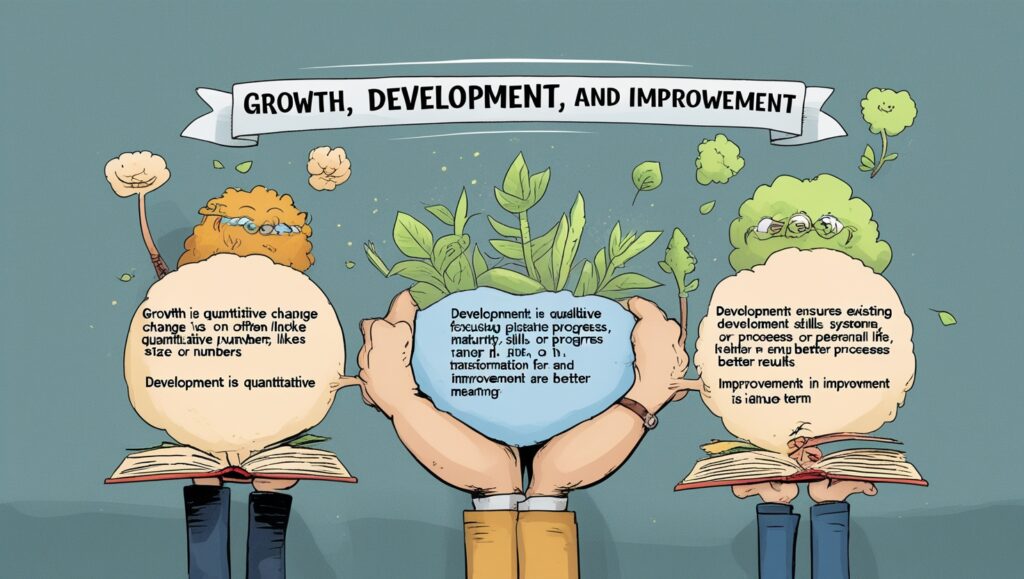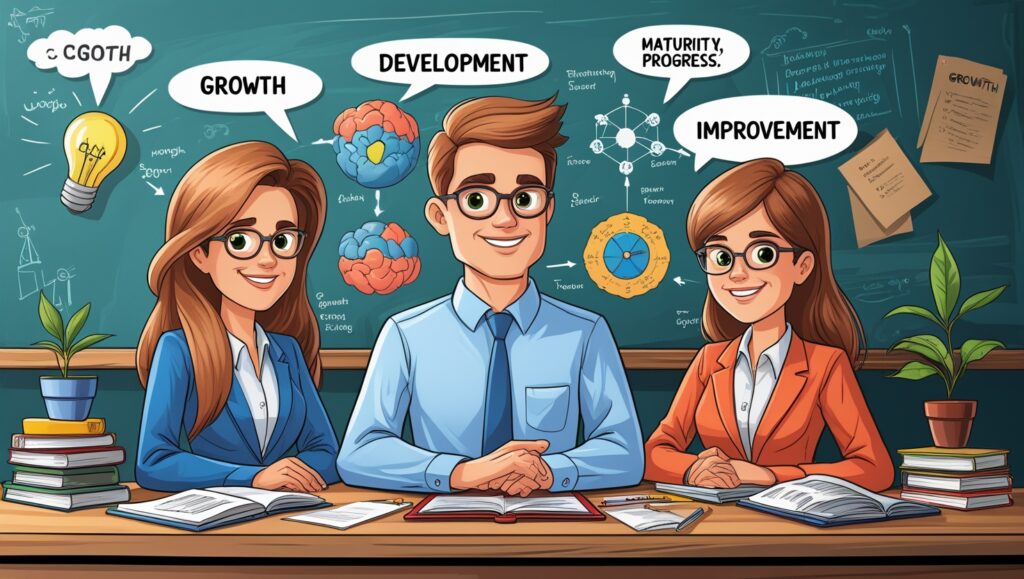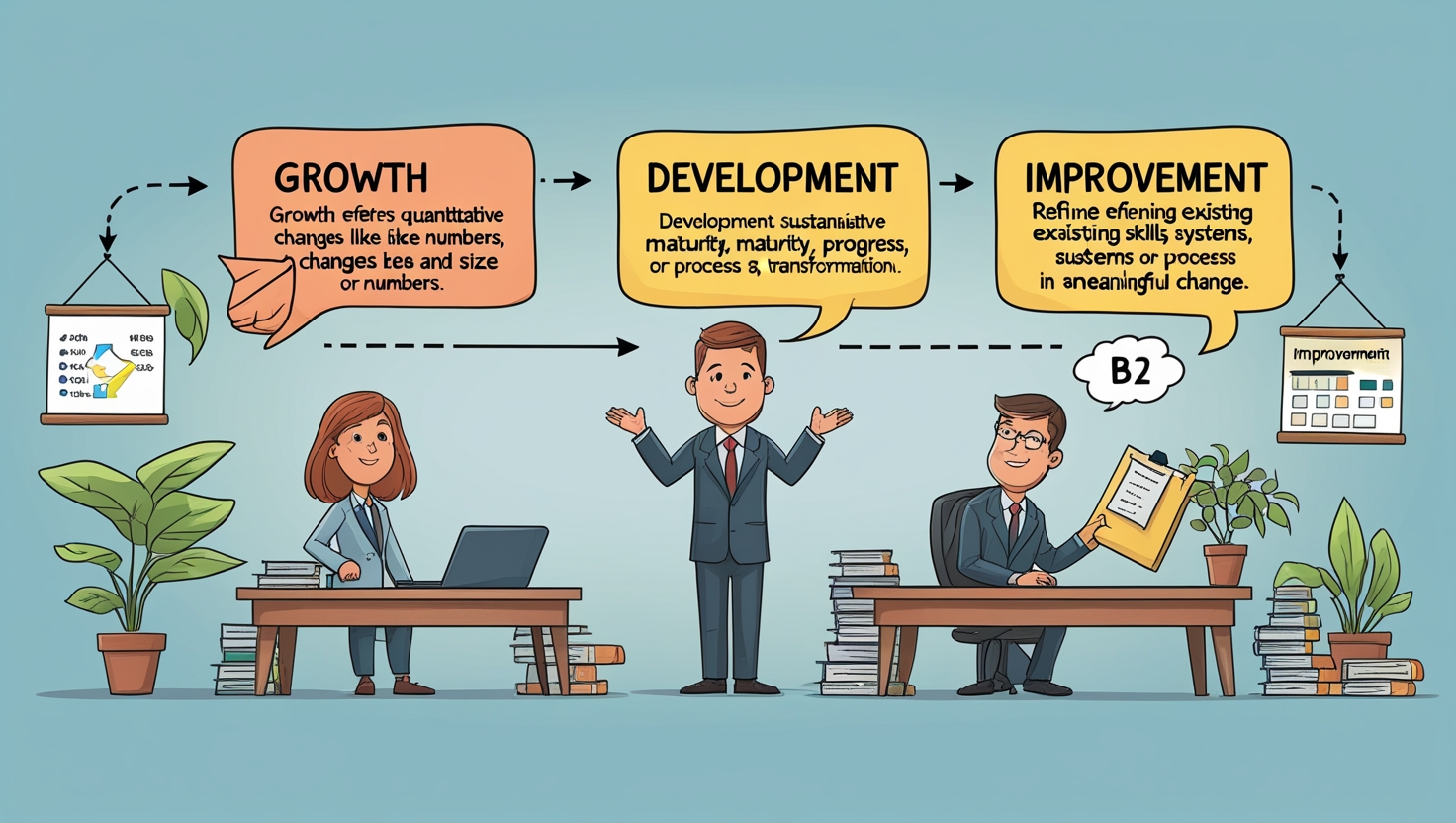Introduction
Growth vs Development vs Improvement, The terms growth, development, and improvement are often used interchangeably. However, they carry different meanings in education, business, and personal life. Growth usually refers to an increase in size, quantity, or capacity. Development focuses on progress, maturity, and overall transformation. Improvement highlights positive changes aimed at making something better. Although these concepts overlap, each has its own distinct purpose. Moreover, their applications vary across fields such as education, economics, psychology, and organizational studies. Understanding these differences helps individuals and institutions plan effectively. For example, a business may experience growth in revenue but lack development in employee skills. Similarly, a student may improve exam scores but still need personal development. Therefore, analyzing these three concepts together provides a holistic view of progress. Ultimately, growth, development, and improvement are interconnected elements that drive long-term success and sustainability.
Defining Growth
Growth is the simplest of the three concepts. It generally refers to measurable changes in size, number, or capacity. For instance, when a company increases sales or a child grows taller, these changes represent growth. Moreover, growth is often quantitative, making it easier to observe and measure. In education, growth can mean higher grades or increased enrollment. In business, it can refer to financial expansion or market share. Furthermore, growth may occur rapidly or gradually, depending on conditions. However, growth alone does not guarantee sustainability. A business can grow quickly but still collapse if not supported by development and improvement. Therefore, growth is best understood as one dimension of progress. While necessary, it is not sufficient for long-term success. Growth needs to be complemented by development and improvement to ensure meaningful and balanced advancement.
Defining Development
Development is a broader and more qualitative concept. It refers to progress, maturity, and transformation. Unlike growth, development emphasizes improvement in structure, capability, and efficiency. For example, a child’s development involves not only physical changes but also emotional, intellectual, and social growth. Similarly, in business, development includes building employee skills, strengthening management, and improving processes. Moreover, development often takes longer and requires planning and effort. It is also multidimensional. It may involve personal development, professional development, or societal development. Furthermore, development is often linked with sustainability. A country may grow economically, but without human development, that growth will not last. Therefore, development goes beyond numbers and focuses on creating balanced and meaningful change. It ensures that growth contributes to long-term progress and prepares individuals and organizations for future challenges.

Defining Improvement
Improvement is about making positive changes to existing systems or practices. It emphasizes quality over quantity. Unlike growth, which measures expansion, or development, which focuses on transformation, improvement deals with refining what already exists. For instance, a student improving study habits shows better performance without necessarily increasing the amount of work. In business, improvement might mean enhancing customer service or streamlining production. Moreover, improvement often relies on feedback and evaluation. Continuous improvement strategies, such as those in quality management, focus on gradual yet consistent progress. Importantly, improvement is achievable even without growth. A company may maintain the same size but still improve its efficiency. Similarly, a person may not develop new skills but can still improve existing ones. Therefore, improvement ensures that both growth and development are effective and sustainable. It is the fine-tuning process of progress.
Growth vs Development
Although related, growth and development differ significantly. Growth is usually quantitative, focusing on numbers or size. Development, on the other hand, is qualitative, emphasizing progress and maturity. For example, a school may grow by increasing student enrollment. Yet, without proper teacher training and curriculum enhancement, the school may not develop. Moreover, growth can be temporary if not supported by development. A company may expand rapidly but collapse if its workforce lacks skills. Development ensures long-term stability by strengthening internal systems. Furthermore, growth is visible and measurable, while development may be less obvious. Development often requires deeper evaluation, such as assessing leadership skills or social awareness. Importantly, both growth and development must go hand in hand. Growth provides scale, while development ensures sustainability. Together, they create a balanced pathway toward progress in education, business, and society.
Growth vs Improvement
Growth and improvement also differ in important ways. Growth often focuses on expansion, while improvement emphasizes enhancement. For example, a student’s grades may improve through better study techniques, even without additional subjects or workload. In contrast, growth would involve covering more content or achieving higher marks. Similarly, in a company, growth may mean hiring more employees. Improvement, however, would focus on training existing employees to perform better. Moreover, growth does not always guarantee improvement. A business can grow in size but still provide poor-quality services. Likewise, an individual may grow older without improving habits or attitudes. Therefore, improvement ensures that growth is meaningful and effective. In addition, improvement is often continuous, while growth can happen in phases. Ultimately, improvement refines the benefits of growth, making expansion more sustainable and valuable.
Development vs Improvement
Development and improvement are also interconnected yet distinct. Development focuses on long-term progress and transformation. It often requires structured planning and significant effort. Improvement, however, deals with specific changes aimed at better quality. For instance, professional development may involve years of training and experience. On the other hand, improvement could mean enhancing time management skills within a shorter period. Moreover, development often includes multiple aspects such as emotional, intellectual, and social dimensions. Improvement, in contrast, usually targets one specific area. Another difference is that development is often broader, while improvement is more detailed. However, both are necessary. Improvement supports development by refining skills and processes. Development provides the larger framework within which improvements occur. Therefore, the two concepts complement each other. Together, they ensure that progress is both comprehensive and effective in achieving long-term goals.
Interconnection of Growth, Development, and Improvement
Although growth, development, and improvement are distinct, they are deeply interconnected. Growth provides expansion, development ensures transformation, and improvement refines quality. For example, a school may grow by adding new classrooms. Development ensures teachers receive training to handle larger classes. Improvement focuses on better teaching methods. Similarly, a company may grow in revenue, develop new technologies, and improve customer service. Each element supports the others. Without growth, expansion stalls. Without development, progress remains shallow. Without improvement, quality declines. Moreover, these concepts work best when balanced. Focusing only on growth may create unsustainable progress. Prioritizing only development without growth may limit opportunities. Improvement without growth or development may result in stagnation. Therefore, the three must function together. Their interconnection ensures that progress is meaningful, balanced, and sustainable across education, business, and personal life.
Practical Examples in Education
In education, growth, development, and improvement appear in many forms. Growth can be seen in higher enrollment rates or better test scores. Development, however, focuses on enhancing critical thinking, creativity, and emotional intelligence. Improvement often relates to refining teaching methods or learning resources. For instance, a school may grow by adding more students. Development occurs when the curriculum evolves to include modern skills. Improvement happens when teachers adopt innovative teaching strategies. Moreover, students also experience these processes. They grow by learning new subjects, develop by building life skills, and improve by practicing effective study habits. Importantly, all three contribute to better learning outcomes. Without growth, opportunities are limited. Without development, progress lacks depth. Without improvement, quality declines. Therefore, a balanced approach is essential. Schools, teachers, and policymakers must integrate all three concepts to ensure effective education systems.

Practical Examples in Business
The business world provides clear examples of growth, development, and improvement. Growth is visible when a company increases revenue, employees, or market share. Development, however, involves building strong organizational culture, leadership, and innovation. Improvement focuses on refining processes, products, and customer service. For example, a retail company may grow by opening new branches. Development occurs when it invests in employee training and technology. Improvement happens when it enhances customer satisfaction through better service. Moreover, growth alone is not enough. Many companies grow rapidly but collapse due to lack of development and improvement. On the other hand, a company that develops skills and improves services sustains long-term success. Therefore, the balance of these three elements determines business sustainability. When integrated, growth, development, and improvement ensure competitive advantage and resilience in changing markets.
Practical Examples in Personal Life
In personal life, growth, development, and improvement play equally important roles. Growth may refer to physical changes, such as height or strength. Development involves emotional maturity, knowledge, and social skills. Improvement means refining habits, attitudes, or daily routines. For example, a person may grow older with time. Development occurs when they build resilience, responsibility, and wisdom. Improvement takes place when they adopt healthier lifestyles or better communication skills. Moreover, growth is automatic in many ways, while development and improvement require conscious effort. Importantly, personal progress relies on balancing all three. Growth provides the foundation, development shapes character, and improvement ensures quality. Without development, growth may lack purpose. Without improvement, both growth and development may stagnate. Therefore, individuals must actively pursue development and improvement while recognizing the natural process of growth. Together, these ensure a fulfilling personal life.
Challenges in Balancing the Three
Balancing growth, development, and improvement is not always easy. One major challenge is resource limitation. For instance, schools may focus on growth by increasing enrollment but lack funds for development or improvement. Similarly, businesses may expand quickly without investing in employee training. Another challenge is short-term thinking. Many organizations prioritize immediate growth while ignoring long-term development. Moreover, improvement often requires consistent effort, which some may overlook. Cultural and social factors also play a role. In some communities, growth is valued more than development or improvement. Furthermore, rapid technological changes make balance difficult. Organizations must constantly adapt to stay competitive. To overcome these challenges, leaders need vision and planning. Balanced strategies ensure that all three elements receive attention. Ultimately, addressing these challenges is essential for sustainable progress in education, business, and personal life.
Conclusion
Growth, development, and improvement are three interconnected concepts that shape progress. Growth focuses on expansion and measurable changes. Development emphasizes maturity, transformation, and sustainability. Improvement refines quality and enhances existing systems. While distinct, they complement one another. In education, business, and personal life, balancing these elements ensures meaningful progress. However, focusing on only one aspect can create imbalance. Growth without development may be shallow. Development without growth may be limited. Improvement without either may stagnate. Therefore, all three must work together. Practical examples show that their integration leads to better outcomes in schools, companies, and individuals’ lives. Despite challenges, balanced strategies make progress sustainable. Ultimately, understanding growth, development, and improvement allows societies, organizations, and individuals to create lasting impact. Their combined influence paves the way for a brighter, more resilient, and successful future.
References
- Sen, A. (1999). Development as Freedom. Oxford University Press.
- Todaro, M. P., & Smith, S. C. (2015). Economic Development. Pearson.
- Deming, W. E. (1986). Out of the Crisis. MIT Press.
- Erikson, E. H. (1993). Childhood and Society. W. W. Norton & Company.

pze4xs